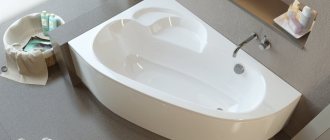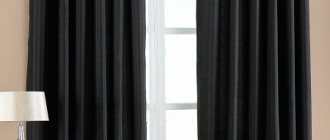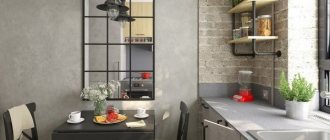- Protects furniture, walls, ceilings and textiles from the appearance of grease and soot;
- Removes and cleans the air from smoke, odors, combustion products, fumes and other harmful impurities generated during cooking on the stove.
By the way, the air in the kitchen during heat treatment of food becomes the dirtiest in the house.
Therefore, if you cook often, your kitchen is not the smallest and/or you use a gas stove and water heater, then you cannot do without a kitchen hood. Do you need a hood in the kitchen? Our answer is yes, you really need it if you cook regularly, use a gas stove, and also if your kitchen has more than 10 square meters of area or is combined with a living room/hallway
However, in order for the hood to really bring benefits and not stand idle, it must be chosen correctly: in terms of performance, operating mode, umbrella size and design. Our 8-step guide with photographs of appliances in the interior will help you understand all the nuances of choosing a kitchen hood.
What parameters should you use to choose a kitchen hood?
The efficiency of the equipment depends on the characteristics that should be taken into account when choosing a device. The performance of the hood affects the quality of its operation. A correctly selected device will improve air circulation in the kitchen by 6-10 times. Modern equipment is equipped with high-power fans that can operate at two to four speeds and ensure the removal of clogged air. The surface cover of the equipment must cover the stove.
An important criterion when selecting a hood is the noise level it produces during operation. A good hood creates noise not exceeding 45 decibels. It can be compared to a quiet conversation taking place at a distance of 10 meters.
Another tip is to choose equipment that is equipped with a lighting system with halogen or LED lamps. Lighting devices are located on the hood panel.
Appearance and dimensions
There are the following types of equipment:
- Hanging. They are low cost, easy to install, and popular in Russia. They operate in recirculation mode, the filter elements are reusable.
- Dome. Externally similar to an umbrella, they are fixed on the wall surface above the hob. Both recirculation and flow modes are provided.
- Built-in. Installed in a hanging cabinet, the bottom of which is open.
- Island. Optimal for kitchens where the stove is located in the center, away from the wall surface. They operate in flow mode.
- Retractable. The advantage of such hoods is their compactness. By moving the panel it is possible to clear the air over the entire cooking surface.
What dimensions should the equipment have? When selecting a device, you need to take into account the dimensions of a gas or electric stove. To prevent clogged air from bypassing the fan, the width of the panel should be slightly larger than the width of the stove.
See also
How to choose the right refrigerator for your home, rating the best models
Manufacturers produce equipment with a width of 50-100 centimeters. Consumers give preference to devices whose body is 60 or 90 centimeters wide.
Device power and performance
It cannot be said that the choice of a kitchen hood is made according to the power indicator, because this parameter is expressed in watts. Rather, the device is selected based on productivity, measured in cubic meters per hour.
Calculating productivity is quite simple. Multiply the area of the kitchen space by the height and by 12. You need to multiply exactly by 12, in accordance with the sanitary standard (the equipment must purify at least 12 cubic meters of air in one hour). In addition, you need to take into account the power reserve, adding 20 percent of it to the resulting result.
The general rule is to buy an electric hood with a capacity of at least 550 cubic meters per hour.
Filtration systems
Based on the type of filtration system, hoods are divided into single-stage and two-stage; as well as for equipment of the first and second levels. Single-stage devices use a disposable/reusable filter element. A disposable filter is replaced with another one after contamination; in a reusable filter, only the internal cassette is replaced. In two-stage hoods, the air is first cleaned of fatty particles, after which unpleasant odors are eliminated.
Level 1 hoods are equipped with acrylic/steel filters. They clean the air by washing it. Second-level devices equipped with a carbon filter element are much more effective.
All hoods are equipped with a filter that protects the ventilation shaft from carbon deposits. Filtration elements made of metal consist of foil or aluminum. They are easy to clean and can be washed in the dishwasher.
Grease-catching
The grease-catching filtration element, made of synthetic fibers, ensures almost complete silence. It includes a cassette with non-woven/sintepon material. Once the filter is clogged, the cassette is pulled out and replaced with another one.
Carbonic
Carbon filter elements efficiently clean the air from dirt and odors. In addition to activated carbon, they include cation exchangers, silver, and other components that promote disinfection. The main disadvantage of such filters is that they are expensive. Also, carbon filter elements have a short service life. They need to be replaced regularly, approximately every six months to a year. The frequency of replacement depends on how thick the layer of carbon powder is.
See also
How to install a sink above the washing machine in the bathroom with your own hands
Noise level
Before purchasing a device, ask the seller how quiet it is. When selecting a hood based on noise level, rely on the following facts:
- 60 decibels – normal conversation at a distance of one meter;
- 90 decibels – scream;
- 100 decibels – lawn mower.
Give preference to devices whose noise level does not exceed 45 decibels.
Backlight quality
Choose equipment equipped with halogen/LED bulbs. Such lighting fixtures create a stream of light that is optimal for cooking.
Material of manufacture
Inexpensive equipment is made from heat-resistant plastic material with metal inserts. Equipment with a metal casing (aluminum or steel) is more expensive. Devices made from wood cost the most. In any case, you need to choose equipment taking into account your own budget.
Control Panel
Based on the control method, it is possible to distinguish 3 types of equipment: push-button, slider, touch. Remote controlled devices that use a remote control are not very popular.
Push-button
The most common option. The keys are used to change operating modes.
Slider or slider
You need to control the hood using a special slider that switches operating modes.
Touch
The device is controlled by lightly touching the corresponding area. After touching, the lamp lights up and the equipment executes the received command.
Advantages and disadvantages of hoods with ventilation outlet
Pros:
- Bad air, combustion products, and moisture are completely removed. In kitchens with gas stoves, this is the most effective way to purify the air.
- Flow hoods in the standard 60 cm size are more efficient than other types of the same size.
- The flow-through model has only a grease filter that can be washed in the dishwasher. A large number of filters slows down the flow of air, reducing performance when power consumption is high.
- They are simpler and cheaper to maintain. For normal operation, you need to remove and clean the grease filters once every 6 months.
- Installing a dual-engine model allows you to service a fairly large area of the room.
But this design has limitations:
- During constant operation, a supply of fresh air is required. Otherwise, reverse draft may appear from the ventilation shaft. Installing a check valve at the ventilation outlet will solve the problem of reverse draft.
- An aesthetic problem is masking the air duct. Wise choice of materials.
- In Soviet-style houses, the ventilation system does not always meet the requirements for full operation: ventilation ducts have a smaller cross-section and can be clogged with building materials.











